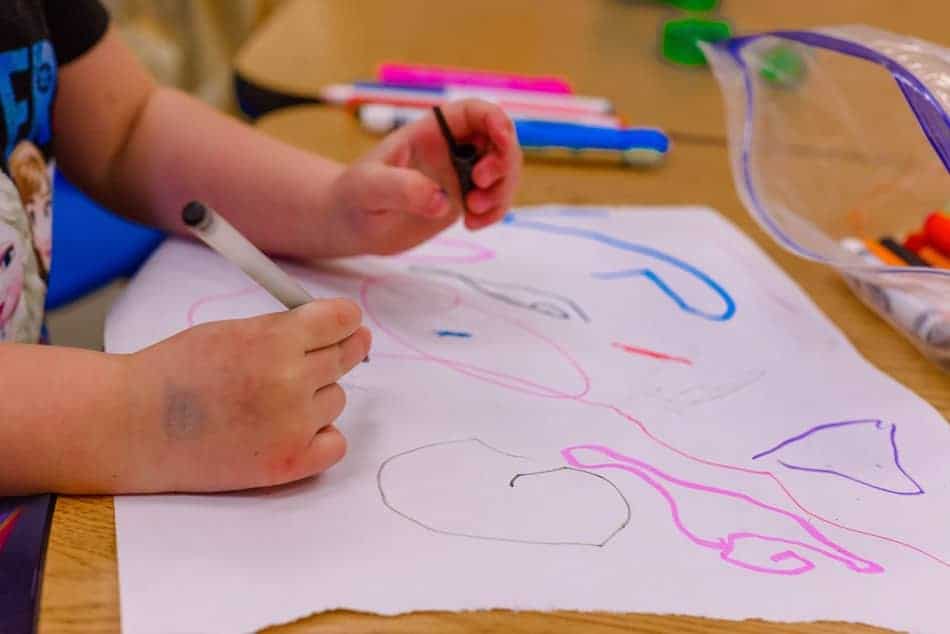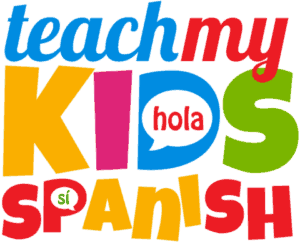
Ever since my daughter was born, I have been researching how she can become fluent in Spanish. One of the things that piqued my interest is Spanish immersion schools. I did some research on Spanish immersion Kindergartens and decided to write a helpful post to share my findings.
So, what are the quick pros and cons of a Spanish Immersion Kindergarten? Will these types of schools benefit my kids? Or should I look at other options first?
What Does Spanish Immersion Mean?
The first question you might have is what is Spanish immersion? I had never heard that term before until I started researching schools for my daughter. I remember asking myself, “What exactly is immersion and how is it involved with learning Spanish?”.
For starters, immersion is a process where you are fully engrossed in a subject. For learning a new language, immersion is the process of learning a foreign language by having it taught exclusively to you. That means that the instructors will only speak to you in Spanish so that you are fully engrossed in the language.
I know what you’re thinking . . . do they ever cheat and talk in English? The answer is no. The purpose of an immersion program is to force your brain to think and respond in Spanish. If the instructors cheat and speak in English from time to time, then it keeps your child’s brain from growing and stretching to learn the new language.
But don’t worry, the teachers do speak English to the parents so that they understand what is happening with their child at school.
What are the Pros and Cons of Spanish Immersion Programs?
If you ask me, I would argue that immersion of a new language is a fantastic idea. But there have to be pros and cons of going to a Spanish immersion school. Not everything can be positive, right? Here is a breakdown of the pros and cons that people shared about Spanish immersion schools.
Pros of Spanish Immersion Programs
1. Immersion School is the Best Way to Learn Spanish
First of all, Spanish immersion schools are arguably the absolute best way for a child to learn Spanish. The younger a child starts at a Spanish immersion school, the less likely they will notice that they are actually trying to learn a new language. Learning Spanish will come naturally to them and time will fly by.
2. Spanish Immersion Programs Will Help Kids Better Learn English
Second, immersion programs help kids learn a foreign language, but they can also help your kid learn their native language. Children are able to learn two languages at the same time. So if they are able to learn something in their foreign language, then it may be able to easily cross-over to their native language. Lessons from one language can apply to the other.
3. Diverse Group of Students and Families
Third, Spanish immersion schools tend to have a very diverse group of students. The families at immersion schools tend to be a little more open-minded and forward-thinking, which generally attracts a diverse group of families. Diversity and inclusion can help children learn about different kinds of people.
4. Appreciate New Cultures
Fourth, not only will the immersion programs have diverse student populations, but it will allow your child to appreciate new cultures. Specifically, by learning Spanish, it will only be natural for Spanish culture to be incorporated into the curriculum. The children will learn about the culture and come to appreciate it.
For example, here is a Ted Talk video discussing how an Israeli dual-language school brought an appreciation for different cultures and allowed a community to grow closer.
5. Your Child Will Become Bilingual
Fifth, your child will become bilingual (or even multilingual). Yes, it is simple to say, but don’t forget one of the main reasons why you will want to send your child to an immersion school. That reason is so that they become bilingual and can communicate with more people.
Personally, my hope is that my daughter is able to learn English and Spanish. Once she has a good feel for English and Spanish, I hope that she continues learning a third language and maybe even a fourth language.
6. Learning a Second Language Makes It Easier to Learn Another Language
That brings us to our next point. Sixth, learning a second language makes it easier to learn a third or even fourth language. Learning two languages in school will grow and stretch your child’s brain. This growing and stretching are from learning a new language. Once this muscle has formed in your brain, it is able to quickly help when you try to learn a third or fourth language.
7. Future Career Opportunities
Seventh, it will provide your children with future career opportunities. Being fluent in Spanish will open up more opportunities for your child due to being able to speak two languages. It will also increase their marketability and likely their future earning potential based simply on the fact that they know two languages fluently. We are moving towards a more globally integrated world, so knowing more than one language will become vital going forward.
8. Improved Memory
Eighth, your child’s working memory will improve due to Spanish immersion programs. Learning two languages allows a child to “compartmentalize” things in each language. For example, a child may mentally place something in their English memory bucket and something else in their Spanish memory bucket. When they need it, they can recall from the English or Spanish memory bucket, which also helps improve their memory.
If the points above did not convince you of the advantages of bilingual education, here is a video from a Wisconsin school district discussing the benefits of learning two languages in school.
Cons of Spanish Immersion Programs
I think the benefits of Spanish immersion schools far outweigh the negatives, but I did not want to ignore the cons and push them to the side. Below are some cons to consider when deciding if you want to send your kids to a Spanish immersion school. Again, I think that the advantages outweigh the disadvantages.
1. Initial Growing Pains for a Kid at a Spanish Immersion School
The first con in sending your kid to a Spanish immersion school will be the initial growing pains. Children don’t like major changes to begin with. Moving to a new school qualifies as a major change in a child’s life. The school, teachers, facility, and kids are all new. These are all new things that they have to adapt to.
However, people have found that this transition period is typically about three months. During the first month, children will vehemently resist the change in schools. They will have crying bouts and express their frustration. During the second month, children will begin to open up, accept their new friends, and trust their new teachers. By the third month, children will be happy and comfortable at their new school. From there, learning should accelerate.
2. Your Child Will Be Extra Tired and Moody
The second con is that your child will become extra tired and moody due to the new amount of information their brain is tackling. Have you tried to learn a new subject recently where you stretched your brain? It can be mentally exhausting. This is what it is like for a child to learn a second language all the time. They can become tired and moody due to all the extra brainpower.
3. Your Child Will Initially Develop in English Slower
Third, your child will develop English slower than the other kids her age, but don’t worry. Over time, your kid will catch up to the other kids her age. Typically, kids learning a second language catch up with the other children sometime in elementary school.
4. Learning Specific Content Can Be Difficult
Last, learning specific content in a foreign language, like math and science, can be difficult. You are concentrating on processing the information in your second language, but that processing can get in the way of you actually learning math and science.
How do Spanish Immersion Programs Differ from Dual-Language Programs?
As we discussed above, there are Spanish immersion schools where the schools teach only in Spanish to the kids. In dual-language programs, the schools will teach in both English and Spanish. This means that children are learning both languages from their schools.
The amount of English and Spanish taught in a dual-language program will depend on the school. Some schools implement their curriculum where they teach 10% in English and the remaining 90% in Spanish. Other schools choose to teach 50-50 where 50% is taught in English and the other 50% is taught in Spanish. The percentages can vary depending on each individual school.
In other dual-language programs, the school may choose to have some of the children be native-English speakers and the other children be native-Spanish speakers. This allows the kids to learn from each other. All of the kids together will learn in English and Spanish. The kids are learning their native language and also learning a second language. At the same time, they are interacting with other children to help them learn.
Are There Benefits to Being Bilingual?
In short, yes, there are benefits to being bilingual. Below are some of the ways that being bilingual is beneficial.
Able to Communicate With More People
By being bilingual, you will be able to communicate with more people. If you know Spanish and English, then you could order your meal at a Mexican restaurant in Spanish. Or you may find yourself having a quick conversation in your second language while you are out on the town.
More Career Opportunities
Also, your career opportunities are expanded. Employers are looking for people who are able to communicate with people in several languages. So by speaking more languages, you make yourself more marketable and in turn, increase your value.
Easier to Travel to Foreign Language Countries
Further, you are able to travel easier. If you are fluent in both English and Spanish, then it is easier for you to travel to a Spanish speaking country. When you are traveling to a Spanish speaking country, you are able to speak and read the language. This will allow you to find where you want to go, visit restaurants or supermarkets, etc.
Easier for Bilingual Parents to Raise Bilingual Children
Also, being bilingual means that you can raise bilingual children. If you are like me, you are fluent in your native language (mine is English), but you only have a basic understanding of a second language (mine is Spanish). However, if you are fluent in more than one language, then you can also teach your kids those languages.
I often find myself day-dreaming of how easy it would be to teach my daughter Spanish if I was fluent.
Improved Health
Last, being bilingual can improve your health. Studies have shown that being bilingual has delayed the onset of Dementia and Alzheimer’s Disease. Other studies have shown that being bilingual can help you recover quicker from a stroke and reduce your stress levels.
